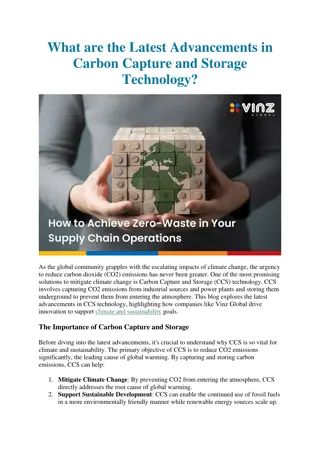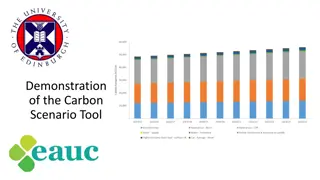Sustainable Carbon Storage Methods for Climate Change Mitigation
Explore effective methods for greenhouse gas removal, including forest management, peatlands and wetlands restoration, enhancing carbon storage in soil, and using wood in construction. Discover the potential advantages and disadvantages of each approach as outlined by the Royal Society and Royal Academy of Engineering in 2018.
Download Presentation

Please find below an Image/Link to download the presentation.
The content on the website is provided AS IS for your information and personal use only. It may not be sold, licensed, or shared on other websites without obtaining consent from the author.If you encounter any issues during the download, it is possible that the publisher has removed the file from their server.
You are allowed to download the files provided on this website for personal or commercial use, subject to the condition that they are used lawfully. All files are the property of their respective owners.
The content on the website is provided AS IS for your information and personal use only. It may not be sold, licensed, or shared on other websites without obtaining consent from the author.
E N D
Presentation Transcript
Chris Stark UK Committee on Climate Change INTRODUCTION TO GREENHOUSE GAS REMOVAL METHODS 1
Forests and better forest management Infographic from the Royal Society and Royal Academy of Engineering (2018) 2
Forests and better forest management Potential advantages Costs are relatively low Potential to store carbon is well known and understood Could store significant amount of carbon dioxide Potential disadvantages It takes time for trees to mature (at least 10 years) Uses land that could be used for other activities Could have a negative impact on biodiversity 3 3
Peatlands and wetlands Infographic from the Royal Society and Royal Academy of Engineering (2018) 4
Peatlands and wetlands Potential advantages We know how to restore peatlands and wetlands A quick way to store carbon at relatively low cost Could have other economic environmental benefits Potential disadvantages Understand less about the science of storing carbon in these places for a long time Uses land that could be used for something else Limited potential: only some areas of the UK are suitable 5
Enhancing the storage of carbon in soil Infographic from the Royal Society and Royal Academy of Engineering (2018) 6
Enhancing the storage of carbon in soil Potential advantages Well-understood method that can be implemented now Could have a low cost Could have other economic and environmental benefits Potential disadvantages Requires changes to modern farming practices Farmers may need financial support from government Could reduce amount of food that can be produced from a given area of land 7 7
Using wood in construction Infographic from the Royal Society and Royal Academy of Engineering (2018) 8
Using wood in construction Potential advantages Wood has been used in construction for centuries A relatively low cost way to store carbon Reduces carbon emissions by replacing other carbon- intensive materials Potential disadvantages Requires changes to modern building practices May mean very tall buildings are not possible Scale might be limited by availability of sustainable sources of wood 9 9
Bioenergy with carbon capture and storage (BECCS) Infographic adapted from the Royal Society and Royal Academy of Engineering (2018) 10
Bioenergy with carbon capture and storage (BECCS) Potential advantages Could capture and store a significant amount of carbon dioxide emissions Combines technologies that are well understood Lots of storage space in the UK (e.g. oil and gas fields) Potential disadvantages Likely to have high costs, at least initially Uses land that could be used for other activities Need to ensure that carbon dioxide storage is secure 11
Direct air capture and carbon storage Infographic adapted from the Royal Society and Royal Academy of Engineering (2018) 12
Direct air capture and carbon storage Potential advantages Could capture and store a significant amount of carbon dioxide emissions Lots of storage space in the UK (e.g. oil and gas fields) A variety of technical options are being developed Potential disadvantages Technologies are very new and experimental Could require a large amount of low carbon electricity Current costs are very high, though they could fall as technology improves 13 13























